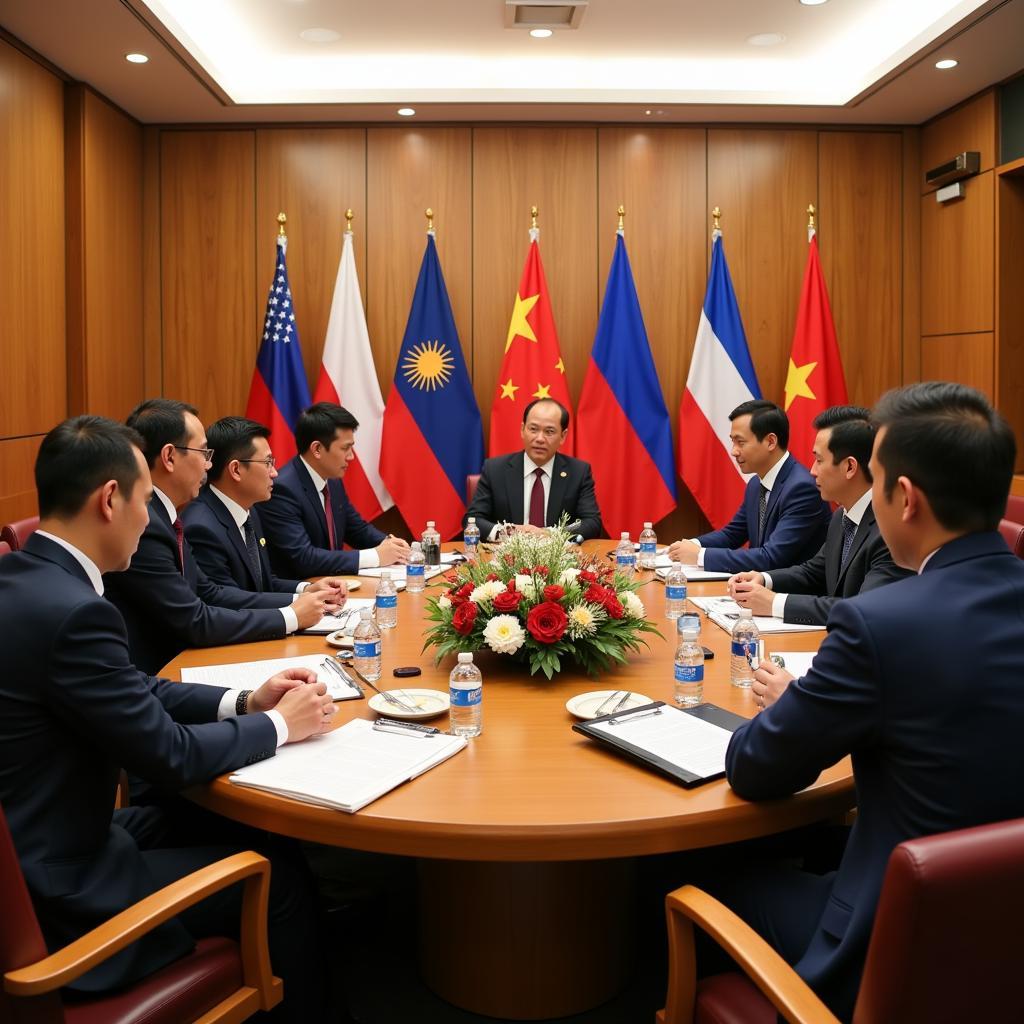The Association of Southeast Asian Nations (ASEAN) is a regional intergovernmental organization comprising ten Southeast Asian countries. It was formed on 8 August 1967 by Indonesia, Malaysia, the Philippines, Singapore, and Thailand. Since then, Brunei Darussalam, Vietnam, Laos, Myanmar, and Cambodia have joined, forming a diverse and dynamic bloc. At its heart, ASEAN aims to accelerate economic growth, promote social progress, and foster cultural development within a framework of peace and stability. This article delves deeper into the comprehensive Aims And Goals Of Asean, exploring its impact on Southeast Asia and beyond.
Fostering Economic Integration and Growth
One of the primary aims and goals of ASEAN is to create a single market and production base, allowing for the free flow of goods, services, investment, and skilled labor within the region. This economic integration is driven by various initiatives, including the ASEAN Free Trade Area (AFTA) and the ASEAN Comprehensive Investment Agreement (ACIA), aiming to reduce trade barriers and attract foreign direct investment.
Promoting Social Progress and Development
ASEAN is committed to improving the lives of its citizens. Recognizing that economic growth must be inclusive and sustainable, ASEAN focuses on social development in key areas such as poverty reduction, healthcare, education, gender equality, and environmental protection. Initiatives like the ASEAN Socio-Cultural Community (ASCC) blueprint reflect this commitment by promoting collaboration in education, culture, and social welfare.
Enhancing Regional Peace and Security
Peace and stability are prerequisites for economic growth and social progress. ASEAN has been instrumental in fostering dialogue and cooperation among member states to address regional security challenges such as territorial disputes, transnational crime, and terrorism. Mechanisms like the ASEAN Regional Forum (ARF) and the East Asia Summit (EAS) provide platforms for dialogue and cooperation on political and security issues.
 ASEAN Security Cooperation
ASEAN Security Cooperation
Strengthening ASEAN Identity and Unity
ASEAN strives to foster a sense of community and shared identity among its diverse population. Through cultural exchanges, educational programs, and sporting events, ASEAN aims to promote understanding and appreciation of the region’s rich cultural heritage and foster a spirit of unity and solidarity among its people.
Maintaining ASEAN Centrality in Global Affairs
In an increasingly interconnected world, ASEAN seeks to maintain its central role in shaping the regional and global agenda. By engaging with dialogue partners like the United States, China, Japan, and the European Union, ASEAN aims to promote multilateralism, open regionalism, and a rules-based international order.
ASEAN’s 2025 Vision: A Glimpse into the Future
Building upon past achievements, ASEAN has outlined its vision for 2025, aiming to create a more integrated, cohesive, and resilient community. This vision focuses on five key areas: a highly integrated and cohesive ASEAN; a competitive, innovative, and dynamic ASEAN; an ASEAN with enhanced connectivity and sectoral cooperation; a resilient, inclusive, people-oriented, and people-centered ASEAN; and a global ASEAN.
[asean-2015-goals-summary] provides a detailed overview of ASEAN’s previous goals, showcasing the organization’s commitment to continuous improvement and development.
Conclusion
The aims and goals of ASEAN reflect a shared commitment to regional integration, economic prosperity, social progress, and peace and security. While challenges remain, ASEAN’s continued efforts to achieve these objectives have significantly contributed to Southeast Asia’s remarkable transformation over the past five decades. As ASEAN moves forward, its commitment to these core principles will remain crucial in navigating the complexities of the 21st century and realizing its vision of a peaceful, prosperous, and integrated Southeast Asian community.
FAQs
1. What is the role of ASEAN in resolving regional disputes?
ASEAN plays a crucial role in facilitating dialogue and promoting peaceful resolution of regional disputes, primarily through consensus-building and consultation mechanisms like the ARF.
2. How does ASEAN promote economic cooperation among its member states?
ASEAN promotes economic cooperation through initiatives like AFTA and ACIA, aiming to reduce trade barriers, harmonize regulations, and create a more favorable investment climate.
3. What are the key challenges facing ASEAN in achieving its goals?
Some key challenges include narrowing the development gap between member states, managing territorial disputes, combating transnational crime, and adapting to a rapidly evolving geopolitical landscape.
4. How can I get involved in ASEAN activities?
Various opportunities exist to engage with ASEAN, including internships, research fellowships, and participation in youth summits and cultural exchange programs.
5. What is the significance of ASEAN’s relationship with dialogue partners?
ASEAN’s dialogue partnerships are essential for fostering regional stability, promoting economic cooperation, and addressing global challenges through multilateralism.
Need more support? Contact us: Phone Number: 0369020373, Email: aseanmediadirectory@gmail.com, or visit us at: Thon Ngoc Lien, Hiep Hoa, Bac Giang, Vietnam. Our customer support team is available 24/7.
Explore more on: anggota negara asean adalah, asean australia issues, ase type questions answers chapter 38, ase model de vries.
